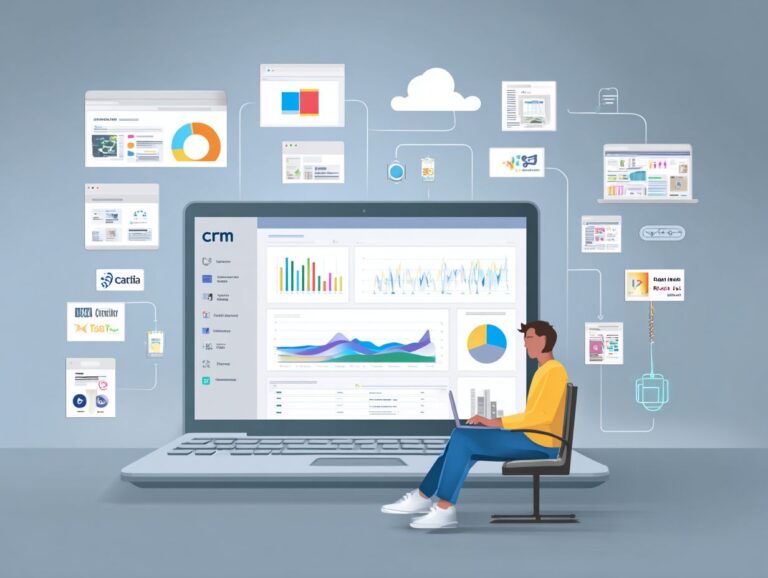CRM Integration: Key Metrics, KPIs, and Real-Time Analytics
Using CRM dashboards to their fullest can improve how your business performs by effectively tracking key performance indicators and providing better data visibility. Organizations can use tools like monday.com to analyze customer data for informed decision-making.
This article talks about key measurements and quick data analysis that are essential for tracking progress and making methods better, helping you stay in front in a competitive setting. Learn how to apply this information for long-term growth!
Key Takeaways:
- Connecting a CRM system effectively helps businesses strengthen customer relationships and increase their growth.
- Key metrics such as CAC and CLV help businesses measure the effectiveness of their CRM integration.
- KPIs such as sales growth rate and lead conversion rate are essential for tracking the success of CRM integration in driving business growth.
- Key Metrics in CRM
- Key Performance Indicators (KPIs)
- Real-Time Analytics in CRM
- Challenges in CRM Integration
- Frequently Asked Questions
- 1. What is CRM Integration and why is it important?
- 2. What are some key metrics to consider when evaluating CRM integration?
- 3. What are KPIs and how can they be used to measure the success of CRM integration?
- 4. How can real-time analytics benefit companies using CRM integration?
- 5. What are some challenges that companies may face when implementing CRM integration?
- 6. What can businesses do to maintain successful CRM integration over time?
1. Importance of CRM in Business

When set up right, a CRM system helps businesses handle customer interactions and information during the relationship, allowing for a personal approach.
For instance, a small caf chain integrated Salesforce to track customer preferences and purchase history. They used this data to tailor their marketing, sending individual promotions based on each person’s shopping patterns. The result? A 30% increase in repeat customers within six months.
monday.com allows businesses to improve communication with clients, helping teams work together well and stay on schedule with follow-ups. Connecting with customers strengthens their commitment by ensuring they feel valued and listened to, which boosts their happiness directly. For an extensive analysis of how technology can enhance customer experiences, explore our Customer Experience And Technology study.
2. Overview of Integration Benefits
Using a CRM offers many benefits, such as better access to data, increased efficiency in operations, and the chance to significantly increase revenue.
Companies that use CRM tools such as Salesforce or HubSpot often see sales conversion rates rise by 25% and customer satisfaction grow by 30%.
By bringing customer interactions into one place, teams can greatly simplify work processes and easily find important information.
For example, using automatic follow-ups and notifications shortens the response time to leads, allowing deals to close more quickly. Detailed analytics allows businesses to identify trends and adjust strategies effectively, maximizing both efficiency and revenue.
Key Metrics in CRM
Knowing important numbers like Customer Acquisition Cost (CAC) and Customer Lifetime Value (CLV) is important for handling CRM and making effective plans.
1. Customer Acquisition Cost (CAC)
Customer Acquisition Cost (CAC) is an important measurement that shows how much is spent to get a new customer. This includes costs related to marketing and sales. To calculate CAC, use the formula: CAC = Total Cost of Sales and Marketing / Total New Customers Acquired.
For example, if you spent $10,000 on marketing and acquired 100 new customers, your CAC would be $100. Benchmark CAC values vary by industry; SaaS companies typically see CAC rates around $200, while e-commerce businesses might aim for $30.
To track CAC correctly, use tools like HubSpot or Zoho CRM. These tools gather data on marketing costs and sales to calculate accurately whenever needed.
2. Customer Lifetime Value (CLV)
Customer Lifetime Value (CLV) helps businesses estimate the total revenue a customer will generate throughout their relationship with the company. To calculate CLV, use the formula: CLV = Average Purchase Value x Purchase Frequency x Customer Lifespan.
For instance, if a Shopify store has an average purchase value of $50, a purchase frequency of 4 times a year, and a customer lifespan of 3 years, the CLV would be $50 x 4 x 3 = $600.
This metric allows businesses to make informed marketing decisions. You can easily monitor these metrics and improve customer engagement approaches by using tools like Glew.io or Shopify Analytics.
Key Performance Indicators (KPIs)

Key Performance Indicators (KPIs) are essential for evaluating how well a business is doing, especially in CRM, where they show details about sales and customer connections. Those curious about the broader impact of customer experience might appreciate our insights on exploring customer experience organizational structures.
1. Sales Growth Rate
The Sales Growth Rate is an important indicator that shows the percent increase in sales over a certain time, giving information about how the business is doing.
[ text{Sales Growth Rate} = frac{text{Current Period Sales} – text{Previous Period Sales}}{text{Previous Period Sales}} times 100].
For example, if last year’s sales were $50,000 and this year they are $70,000, your Sales Growth Rate would be
[ frac{70,000 – 50,000}{50,000} times 100 = 40%].
Tools like monday.com provide dashboards for tracking this data and generating reports, allowing you to visualize trends and make informed decisions quickly.
To calculate the Sales Growth Rate, use the formula:
Sales Growth Rate = (Current Period Sales - Previous Period Sales) / Previous Period Sales x 100.
For example, if last year’s sales were $50,000 and this year they are $70,000, your Sales Growth Rate would be
(70,000 - 50,000) / 50,000 x 100 = 40%.
Tools like monday.com provide dashboards for tracking this data and generating reports, allowing you to visualize trends and make informed decisions quickly.
2. Lead Conversion Rate
Lead Conversion Rate measures the effectiveness of a company’s sales efforts, indicating the percentage of leads that turn into paying customers.
To improve lead conversion rates with CRM tools like Pipedrive, begin by outlining your sales process. Identify key stages, from lead generation to closing.
Pay attention to each step to find where people stop, so you can make specific changes. Next, use Pipedrive’s email templates and follow-up alerts to increase engagement.
Regularly check conversion rates and change plans when needed. If many potential customers lose interest during the demo, consider improving your demo presentations or offer more details to help with decision-making.
Real-Time Analytics in CRM
Real-time analytics in CRM systems allows businesses to quickly make informed decisions by giving them instant information about customer data and behavior. This approach aligns with the principles outlined in our analysis of customer experience and technology and its revolutionary impact on decision-making processes.
1. Definition and Importance
Up-to-date information allows businesses to respond promptly to customer demands and market shifts, resulting in quicker decisions.
For instance, Salesforce provides real-time analytics through its customizable dashboards, enabling teams to track key performance indicators and identify trends instantaneously.
Similarly, Microsoft Dynamics offers detailed reporting tools that allow businesses to examine customer interactions instantly, which helps them react promptly.
By using these tools, companies can make better decisions about their marketing strategies or customer service methods, leading to more efficient operations and happier customers. Using these CRMs increases productivity and encourages an agile environment in the company.
2. Tools for Real-Time Data Analysis

Many CRM tools offer strong features for analyzing data as it happens, allowing businesses to monitor metrics effectively and make practical decisions.
Consider these exemplary CRM tools:
- HubSpot (free-$800/month) offers detailed reporting dashboards and funnels, great for small to large enterprises focusing on sales and marketing alignment.
- Zoho CRM ($12-$100/month) features analytics that enables predictive sales forecasting and performance tracking.
- monday.com (from $8/month) stands out with its customizable dashboards, allowing teams to visualize real-time data trends specific to their workflow.
Each tool offers different benefits based on what your organization needs and how much you can spend, helping you make well-informed choices with up-to-date information.
Challenges in CRM Integration
While adding a CRM system offers many benefits, businesses often face problems that can block successful setup and use.
1. Data Quality Issues
Problems with data quality can weaken CRM performance, resulting in incorrect information and unsatisfactory customer experiences.
To tackle these challenges, implement regular data audits to identify and rectify incomplete or outdated records. Tools like Data Ladder, which help remove duplicates and keep data consistent, can simplify this task.
Schedule these reviews every three months to maintain your CRM’s accuracy and reliability, enhancing customer communication and decision-making. Showing your team the best ways to enter data will help avoid data quality issues later on.
2. Resistance to Change
Resistance to change among employees can hinder the successful adoption of new CRM technologies, impacting overall business performance. To address this resistance, organizations should create detailed training programs that show how the CRM helps with specific job functions.
For example, tools like Userlane can help create interactive onboarding sessions, guiding employees through the CRM as they receive immediate help.
Regular feedback sessions are important because they help spot problems and show employees that their opinions are valued. Creating incentives for early users can persuade more people to accept the change, supporting a culture of new ideas.
3. Emerging Technologies in CRM
New technologies such as artificial intelligence and machine learning will significantly affect CRM practices by offering more detailed information about customer habits.
Businesses use AI chatbots such as Drift and Intercom to improve how they interact with customers. These tools offer immediate help and can manage typical questions easily.
Platforms like HubSpot and Salesforce Einstein study previous customer information to forecast what customers might do next, helping create specific marketing plans.
Companies using these technologies have seen satisfaction levels rise by up to 20% because of customized interactions and quicker replies. Integrating these solutions can significantly improve customer retention and drive sales growth.
Frequently Asked Questions

1. What is CRM Integration and why is it important?
CRM Integration means linking your customer relationship management system with other internal and external systems to gather and organize data in one place. It provides instant access to customer details, which is essential for making decisions based on data and enhancing the overall effectiveness of the business.
2. What are some key metrics to consider when evaluating CRM integration?
Some key metrics to consider when evaluating CRM integration are data accuracy, data completeness, data timeliness, and data consistency. These metrics help evaluate how well the integration process works and confirm that the combined data is trustworthy and current.
3. What are KPIs and how can they be used to measure the success of CRM integration?
KPIs (Key Performance Indicators) are measurable values that demonstrate how effectively a company is achieving its key business objectives. In CRM integration, KPIs help monitor things like how customers interact, the rate at which leads turn into sales, and overall sales results to measure how well the integration is working.
4. How can real-time analytics benefit companies using CRM integration?
Real-time analytics provide immediate information on customer data, enabling companies to make informed decisions and respond promptly. By connecting CRM systems, real-time analytics can give businesses a full view of how customers act, allowing them to tailor interactions and make customers happier overall.
5. What are some challenges that companies may face when implementing CRM integration?
Some challenges that companies may face when implementing CRM integration include data silos, incompatible systems, data security concerns, and resistance from employees. Having a clear plan and committed team is essential to tackle these issues and make the integration process work smoothly.
6. What can businesses do to maintain successful CRM integration over time?
To keep CRM integration successful, companies should frequently check and study important measurements and performance indicators, communicate often with involved parties, keep improving the integration process, and follow new developments in CRM technology and trends.





